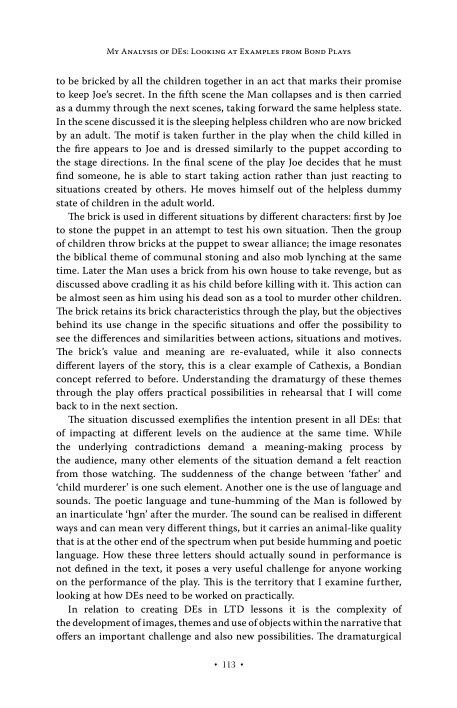

OCR
MY ANALYSIS OF DES: LOOKING AT EXAMPLES FROM BOND PLAYS to be bricked by all the children together in an act that marks their promise to keep Joes secret. In the fifth scene the Man collapses and is then carried as a dummy through the next scenes, taking forward the same helpless state. In the scene discussed it is the sleeping helpless children who are now bricked by an adult. The motif is taken further in the play when the child killed in the fire appears to Joe and is dressed similarly to the puppet according to the stage directions. In the final scene of the play Joe decides that he must find someone, he is able to start taking action rather than just reacting to situations created by others. He moves himself out of the helpless dummy state of children in the adult world. The brick is used in different situations by different characters: first by Joe to stone the puppet in an attempt to test his own situation. Then the group of children throw bricks at the puppet to swear alliance; the image resonates the biblical theme of communal stoning and also mob lynching at the same time. Later the Man uses a brick from his own house to take revenge, but as discussed above cradling it as his child before killing with it. This action can be almost seen as him using his dead son as a tool to murder other children. The brick retains its brick characteristics through the play, but the objectives behind its use change in the specific situations and offer the possibility to see the differences and similarities between actions, situations and motives. The brick’s value and meaning are re-evaluated, while it also connects different layers of the story, this is a clear example of Cathexis, a Bondian concept referred to before. Understanding the dramaturgy of these themes through the play offers practical possibilities in rehearsal that I will come back to in the next section. The situation discussed exemplifies the intention present in all DEs: that of impacting at different levels on the audience at the same time. While the underlying contradictions demand a meaning-making process by the audience, many other elements of the situation demand a felt reaction from those watching. The suddenness of the change between ‘father’ and ‘child murderer’ is one such element. Another one is the use of language and sounds. The poetic language and tune-humming of the Man is followed by an inarticulate ‘hgn’ after the murder. The sound can be realised in different ways and can mean very different things, but it carries an animal-like quality that is at the other end of the spectrum when put beside humming and poetic language. How these three letters should actually sound in performance is not defined in the text, it poses a very useful challenge for anyone working on the performance of the play. This is the territory that I examine further, looking at how DEs need to be worked on practically. In relation to creating DEs in LTD lessons it is the complexity of the development of images, themes and use of objects within the narrative that offers an important challenge and also new possibilities. The dramaturgical e 113"
Szerkezeti
Custom
Image Metadata
- Kép szélessége
- 1831 px
- Kép magassága
- 2835 px
- Képfelbontás
- 300 px/inch
- Kép eredeti mérete
- 1.3 MB
- Permalinkből jpg
- 022_000014/0113.jpg
- Permalinkből OCR
- 022_000014/0113.ocr
Bejelentkezés
Magyarhu
